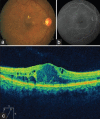Short-term results of intravitreal dexamethasone implant (OZURDEX(®)) in treatment of recalcitrant diabetic macular edema: A case series
- PMID: 22993460
- PMCID: PMC3441033
- DOI: 10.4103/0974-620X.99368
Short-term results of intravitreal dexamethasone implant (OZURDEX(®)) in treatment of recalcitrant diabetic macular edema: A case series
Abstract
Context: Dexamethasone Posterior-Segment Drug Delivery System is a novel, biodegradable, sustained-release drug delivery system (OZURDEX(®)) for treatment of macular edema following retinal vein occlusion and posterior uveitis. However, its potential role in management of diabetic macular edema has not been reported yet.
Aim: The aim was to evaluate the safety and efficacy of (OZURDEX(®)) in patients with recalcitrant diabetic macular edema (DME).
Setting and design: A retrospective, interventional case series from a tertiary eye care center in India is presented. Inclusion criteria comprised patients presenting with recalcitrant DME, 3 or more months after one or more treatments of macular laser photocoagulation and/or intravitreal anti-vascular endothelial growth factor (VEGF) injections. Exclusion criteria included history of corticosteroid-responsive intraocular pressure (IOP) rise, cataract extraction, or other intraocular surgery within 3 months. The main outcome measure was visual acuity at 1 and 4 months after OZURDEX(®) injection. Secondary outcome measures included change in central macular thickness on Optical coherence tomography (OCT) and changes in IOP following intravitreal OZURDEX(®) implant. Of 18 eyes (17 patients) with recalcitrant diabetic macular edema that underwent OZURDEX(®) implant, three eyes (two patients) had follow-up of more than 3 months post-injection.
Results: Mean age of patients was 56 years. Mean duration of diabetes mellitus was 16.6 years. Systemic control of DM was good as assessed by FBS/PPBS and HbA1c. The pre-operative mean central macular thickness was 744.3 μm and improved to 144 and 570 μm at months 1 and 4, respectively. Preoperative mean BCVA was 0.6 logMAR units and improved to 0.3 and 0.46 logMAR units at month 1 and 4, respectively. The mean follow-up was 4.3 months (range 4-5 months).
Conclusion: OZURDEX(®) appears efficacious in management of recalcitrant diabetic macular edema. The results of the ongoing POSURDEX(®) study will elaborate these effects better.
Keywords: Dexamethasone; OZURDEX®; diabetes mellitus; diabetic macular edema; intravitreal implant.
Conflict of interest statement
Figures


Similar articles
-
Efficacy and safety of dexamethasone intravitreal implant in patients with retinal vein occlusion resistant to anti-VEGF therapy: a 12-month prospective study.Cutan Ocul Toxicol. 2019 Dec;38(4):330-337. doi: 10.1080/15569527.2019.1614020. Epub 2019 May 27. Cutan Ocul Toxicol. 2019. PMID: 31060385 Clinical Trial.
-
Repeated intravitreal dexamethasone implant (Ozurdex) for diabetic macular edema.Retina. 2015 Jun;35(6):1216-22. doi: 10.1097/IAE.0000000000000443. Retina. 2015. PMID: 25574787
-
[Early efficacy of dexamethasone implant (OZURDEX®) in diabetic macular edema: Real life study].J Fr Ophtalmol. 2017 May;40(5):408-413. doi: 10.1016/j.jfo.2016.10.017. Epub 2017 Mar 21. J Fr Ophtalmol. 2017. PMID: 28336283 French.
-
Retinal vein occlusion and the use of a dexamethasone intravitreal implant (Ozurdex®) in its treatment.Graefes Arch Clin Exp Ophthalmol. 2016 Jul;254(7):1257-65. doi: 10.1007/s00417-016-3350-x. Epub 2016 May 13. Graefes Arch Clin Exp Ophthalmol. 2016. PMID: 27178087 Free PMC article. Review.
-
Comparison between Ozurdex and intravitreal anti-vascular endothelial growth factor treatment for retinal vein occlusion-related macular edema: A systematic review and meta-analysis of randomized controlled trials.Indian J Ophthalmol. 2019 Nov;67(11):1800-1809. doi: 10.4103/ijo.IJO_382_19. Indian J Ophthalmol. 2019. PMID: 31638037 Free PMC article.
Cited by
-
Efficacy of Ozurdex implant in recalcitrant diabetic macular edema--a single-center experience.Int Ophthalmol. 2016 Apr;36(2):207-16. doi: 10.1007/s10792-015-0103-5. Epub 2015 Aug 2. Int Ophthalmol. 2016. PMID: 26233578
-
Preliminary results of an intravitreal dexamethasone implant (Ozurdex®) in patients with persistent diabetic macular edema.Clin Ophthalmol. 2013;7:1423-8. doi: 10.2147/OPTH.S48364. Epub 2013 Jul 16. Clin Ophthalmol. 2013. PMID: 23901252 Free PMC article.
-
Efficacy of single-dose dexamethasone implantation in patients with persistent diabetic macular edema.Int Ophthalmol. 2016 Aug;36(4):531-9. doi: 10.1007/s10792-015-0155-6. Epub 2015 Dec 7. Int Ophthalmol. 2016. PMID: 26644130
-
Short-term Efficacy of Intravitreal Dexamethasone Implant in Vitrectomized Eyes with Recalcitrant Diabetic Macular Edema and Prior Anti-VEGF Therapy.J Ophthalmic Vis Res. 2016 Apr-Jun;11(2):183-7. doi: 10.4103/2008-322X.183928. J Ophthalmic Vis Res. 2016. PMID: 27413499 Free PMC article.
-
Efficacy and Safety of Intravitreal Dexamethasone Implants for Treatment of Refractory Diabetic Macular Edema.Korean J Ophthalmol. 2017 Apr;31(2):115-122. doi: 10.3341/kjo.2017.31.2.115. Epub 2017 Mar 21. Korean J Ophthalmol. 2017. PMID: 28367039 Free PMC article.
References
-
- Pelzek C, Lim JI. Diabetic macular edema: Review and update. Ophthalmol Clin North Am. 2002;15:555–63. - PubMed
-
- Funatsu H, Yamashita H, Noma H, Mimura T, Yamashita T, Hori S. Increased levels of vascular endothelial growth factor and interleukin-6 in the aqueous humor of diabetics with macular edema. Am J Ophthalmol. 2002;133:70–7. - PubMed
-
- Antonetti DA, Barber AJ, Khin S, Lieth E, Tarbell JM, Gardner TW Penn state retina research group. Vascular permeability in experimental diabetes is associated with reduced endothelial occludin content: Vascular endothelial growth factor decreases occludin in retinal endothelial cells. Diabetes. 1998;47:1953–9. - PubMed
-
- Leopold IH. Nonsteroidal and steroidal anti-inflammatory agents. In: Sears M, Tarkkanen A, editors. Surgical pharmacology of the eye. New York NY: Raven Press; 1985. pp. 83–133.
-
- Nauck M, Karakiulakis G, Perruchoud A, Papakonstantinou E, Roth M. Corticosteroids inhibit the expression of the vascular endothelial growth factor gene in human vascular smooth muscle cells. Eur J Pharmacol. 1998;341:309–15. - PubMed

